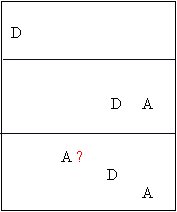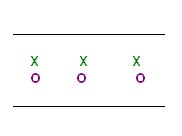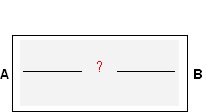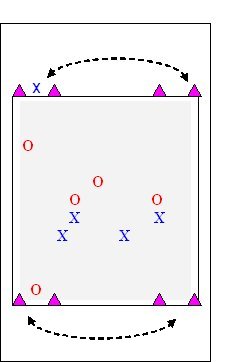COLLECTIVE SPORTS
UNIT: HOCKEY
LESSON: 2
Contents:
TACKLING
SUPPORT IN ATTACK AND DEFENCEAPPARATUS: Hockey sticks, hockey balls, cones, bands.
ORGANISATION
CONTENT
TEACHING POINTS
Number the players: 6 divided into 2 teams, attackers and defenders.

WARM UP; familiarisation with the sticks
1- Breakthrough
Each defender must defend only within their own zone. The grid is divided in three areas, and there is a defender in each. Players may challenge sensibly when defending but must avoid unnecessary stick contact.
Attackers start with a pass from their own end-line and dribble and pass the ball to beat each defender in their zone in order to reach the other end-line (without losing ball to defender). Attackers can go into all the areas.
Attackers score 1 point each time they reach other end without defenders taking the ball. Defenders score 2 points each time they gain the ball.
After attackers score a point or when defenders take the ball, go back to the end-line to begin again.
Changes to the game
- Defenders only score 1 point each time they gain the ball (use this when defenders are quite skilful).
- Match younger players with similar age players, or pair younger and older players together.
- Allow the 1 st defender to join the 2nd defender in the area behind when beaten. Allow them to join the 3rd defender in the end area when they too are beaten. This makes it harder for attackers when they reach end area.
Easier: increase playing area so that attackers have more room to move.
Harder: decrease the playing area so attackers have less room. Therefore they have to be more accurate and react more quickly.
In groups of 4.
XX------------------------XX
MAIN PART:
Skills; dribble and push
2- Dribble and stop ball for next player:
XX------- ____________XX
Dribble:-------------
Push:____________
3- Dribble and push:
Children are grouped in groups of four. Each group has 2 pupils on one side and 2 pupils on the other. The first one has to go from one side to the other holding the stick and controlling the ball. He/she has to dribble halfway and then push with a continuous action and follow through toward partner. The next players will do the same and so on.

4- Zig-zag dribble:
Children are grouped in groups of four. Each group has 2 pupils on one side and 2 pupils on the other side. The first one has to go from one side to the other holding the stick and controlling the ball in a zig-zag dribble and only using flat side of the stick.
Use cones if there are no lines.

Skills; tackle
5- 1 v 1 start in bully position:
Children are in partners, one has to play against the other. They start in bully position, bully off and then try to dribble over the line to score. They can push or pull the ball to win the tackle no tackling the opponent's stick. They have to try to keep facing the way they are going.

6- 1 v 1 start at either end of the grid.
In partners (A, B). A approximately 2m in front of B.

7- Tackle Back
Children are in partners, one has to play against the other. When the teacher says GO, B chases A and tackles before they arrive at the line. They have to chase and tackle from the right . They must keep the stick low and tackle only when level or in front of partner.
The teacher may adjust the distance between A and B to give B the chance to tackle.
?Why do we tackle from the right? Safety
GAMES;
8- 3 v 2
Children are divided in groups of 5. One team of 3 attackers (X) plays against one team of 2 defenders (O). One defender is in the goal. Attackers try to score shooting the ball in the goal. All three attackers must touch the ball before the shot. They have to try to attack in a triangular formation, not in line. The defender tries to tackle and dribble or pass the ball over the line AB. Attackers should d raw the defender and time the pass before the tackle. It means, the attacker who has the ball should force the defender to come towards him/her and then should time the pass before tackle.
9- 5 v 5
Children are divided in groups of 5 and one team of 5 attackers (X) plays against one team of 5 defenders (O). Each team has two goals in their own end line and a player behind the goals. There should be just one player for the two goals from each team. The team who has the ball has to pass it between them in order to score. To score, the goalkeeper must receive the ball behind either goal.
There should be only one player on the ball from each team at a time Players have to mark only one of the opposite team, they must support each other and move into spaces for an easy pass.